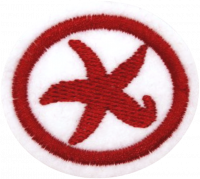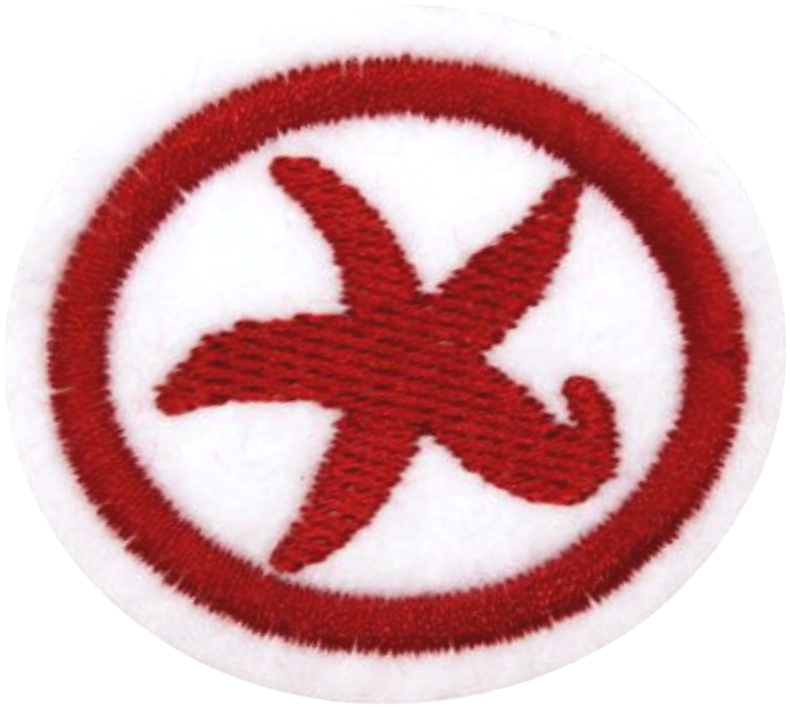Difference between revisions of "AY Honors/Echinoderms/Requirements"
Jomegat bot (talk | contribs) m (Add RequirementsHeader) |
m (- Category of Honor Requirements) |
||
| (9 intermediate revisions by 2 users not shown) | |||
| Line 1: | Line 1: | ||
| − | In | + | {{HonorSubpage}} |
| + | |||
| + | <section begin=Body /> | ||
| + | |||
| + | <b>1. <section begin=req1 /><noinclude><translate><!--T:1--> | ||
| + | </noinclude>In what environment can echinoderms be found? | ||
| + | <noinclude></translate></noinclude><section end=req1 /></b> | ||
| + | |||
| + | <b>2. <section begin=req2 /><noinclude><translate><!--T:2--> | ||
| + | </noinclude>What does the word Echinodermata mean, the name that characterizes the echinoderms? | ||
| + | <noinclude></translate></noinclude><section end=req2 /></b> | ||
| + | |||
| + | <b>3. <section begin=req3 /><noinclude><translate><!--T:3--> | ||
| + | </noinclude>Name four characteristics of the phylum Echinodermata. | ||
| + | <noinclude></translate></noinclude><section end=req3 /></b> | ||
| + | |||
| + | <b>4. <section begin=req4 /><noinclude><translate><!--T:4--> | ||
| + | </noinclude>What kind of symmetry do the echinoderms have? What does this mean? | ||
| + | <noinclude></translate></noinclude><section end=req4 /></b> | ||
| + | |||
| + | <b>5. <section begin=req5 /><noinclude><translate><!--T:5--> | ||
| + | </noinclude>Name the main characteristics and give five examples of the classes of echinoderms: | ||
| + | <noinclude></translate></noinclude><section end=req5 /></b> | ||
| + | |||
| + | :<b>a. <section begin=req5a /><noinclude><translate><!--T:6--> | ||
| + | </noinclude>Asteroidea | ||
| + | <noinclude></translate></noinclude><section end=req5a /></b> | ||
| + | |||
| + | :<b>b. <section begin=req5b /><noinclude><translate><!--T:7--> | ||
| + | </noinclude>Echinoidea | ||
| + | <noinclude></translate></noinclude><section end=req5b /></b> | ||
| + | |||
| + | :<b>c. <section begin=req5c /><noinclude><translate><!--T:8--> | ||
| + | </noinclude>Ophiuroidea | ||
| + | <noinclude></translate></noinclude><section end=req5c /></b> | ||
| + | |||
| + | :<b>d. <section begin=req5d /><noinclude><translate><!--T:9--> | ||
| + | </noinclude>Holothuroidea | ||
| + | <noinclude></translate></noinclude><section end=req5d /></b> | ||
| + | |||
| + | :<b>e. <section begin=req5e /><noinclude><translate><!--T:10--> | ||
| + | </noinclude>Crinoidea | ||
| + | <noinclude></translate></noinclude><section end=req5e /></b> | ||
| + | |||
| + | <b>6. <section begin=req6 /><noinclude><translate><!--T:11--> | ||
| + | </noinclude>What do you do in the event of an accident with sea urchins? | ||
| + | <noinclude></translate></noinclude><section end=req6 /></b> | ||
| + | |||
| + | <b>7. <section begin=req7 /><noinclude><translate><!--T:12--> | ||
| + | </noinclude>In a practical class identify, discover and explain the function of the following structures: | ||
| + | <noinclude></translate></noinclude><section end=req7 /></b> | ||
| + | |||
| + | :<b>a. <section begin=req7a /><noinclude><translate><!--T:13--> | ||
| + | </noinclude>Starfish: | ||
| + | <noinclude></translate></noinclude><section end=req7a /></b> | ||
| + | |||
| + | ::<b>i. <section begin=req7ai /><noinclude><translate><!--T:14--> | ||
| + | </noinclude>Ambulacral grooves or feet | ||
| + | <noinclude></translate></noinclude><section end=req7ai /></b> | ||
| + | |||
| + | ::<b>ii. <section begin=req7aii /><noinclude><translate><!--T:15--> | ||
| + | </noinclude>Madreporite plate | ||
| + | <noinclude></translate></noinclude><section end=req7aii /></b> | ||
| + | |||
| + | ::<b>iii. <section begin=req7aiii /><noinclude><translate><!--T:16--> | ||
| + | </noinclude>Mouth | ||
| + | <noinclude></translate></noinclude><section end=req7aiii /></b> | ||
| + | |||
| + | ::<b>iv. <section begin=req7aiv /><noinclude><translate><!--T:17--> | ||
| + | </noinclude>Anus | ||
| + | <noinclude></translate></noinclude><section end=req7aiv /></b> | ||
| + | |||
| + | :<b>b. <section begin=req7b /><noinclude><translate><!--T:18--> | ||
| + | </noinclude>Sea urchins: | ||
| + | <noinclude></translate></noinclude><section end=req7b /></b> | ||
| + | |||
| + | ::<b>i. <section begin=req7bi /><noinclude><translate><!--T:19--> | ||
| + | </noinclude>Aristotle's Lantern | ||
| + | <noinclude></translate></noinclude><section end=req7bi /></b> | ||
| + | |||
| + | ::<b>ii. <section begin=req7bii /><noinclude><translate><!--T:20--> | ||
| + | </noinclude>Spines | ||
| + | <noinclude></translate></noinclude><section end=req7bii /></b> | ||
| + | |||
| + | ::<b>iii. <section begin=req7biii /><noinclude><translate><!--T:21--> | ||
| + | </noinclude>Mouth | ||
| + | <noinclude></translate></noinclude><section end=req7biii /></b> | ||
| + | |||
| + | ::<b>iv. <section begin=req7biv /><noinclude><translate><!--T:22--> | ||
| + | </noinclude>Endoskeleton | ||
| + | <noinclude></translate></noinclude><section end=req7biv /></b> | ||
| + | |||
| + | <section begin=challenge /> | ||
| + | <b>8. <section begin=req8 /><noinclude><translate><!--T:23--> | ||
| + | </noinclude>Make a collection containing 20 pictures or photographs of different species of echinoderms. Include the common name, scientific name, family and order. | ||
| + | <noinclude></translate></noinclude><section end=req8 /></b> | ||
| + | <section end=challenge /> | ||
| + | |||
| + | <b>9. <section begin=req9 /><noinclude><translate><!--T:24--> | ||
| + | </noinclude>How do starfish feed? | ||
| + | <noinclude></translate></noinclude><section end=req9 /></b> | ||
| + | |||
| + | <b>10. <section begin=req10 /><noinclude><translate><!--T:25--> | ||
| + | </noinclude>Do some research about sea urchins and some species that have poison. | ||
| + | <noinclude></translate></noinclude><section end=req10 /></b> | ||
| + | <section end=Body /> | ||
Latest revision as of 22:10, 20 July 2022
1. In what environment can echinoderms be found?
2. What does the word Echinodermata mean, the name that characterizes the echinoderms?
3. Name four characteristics of the phylum Echinodermata.
4. What kind of symmetry do the echinoderms have? What does this mean?
5. Name the main characteristics and give five examples of the classes of echinoderms:
- a. Asteroidea
- b. Echinoidea
- c. Ophiuroidea
- d. Holothuroidea
- e. Crinoidea
6. What do you do in the event of an accident with sea urchins?
7. In a practical class identify, discover and explain the function of the following structures:
- a. Starfish:
- i. Ambulacral grooves or feet
- ii. Madreporite plate
- iii. Mouth
- iv. Anus
- b. Sea urchins:
- i. Aristotle's Lantern
- ii. Spines
- iii. Mouth
- iv. Endoskeleton
8. Make a collection containing 20 pictures or photographs of different species of echinoderms. Include the common name, scientific name, family and order.
9. How do starfish feed?
10. Do some research about sea urchins and some species that have poison.



